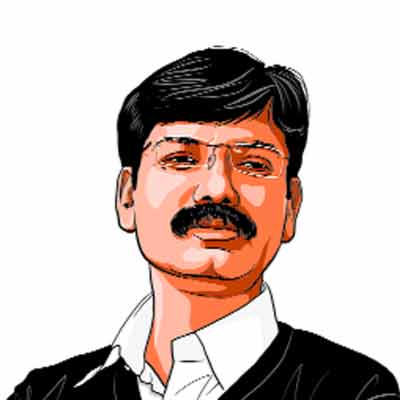Opinion Badri Narayan writes: Ram, Ramayana and Ramcharitmanas are part of a lived faith – politicising them is fraught with peril
Politicians who are trying to use critiques of Ramayana and Ramcharitmanas for public mobilisation miss an important point: “Ramayanic” memories are also popular among SCs, tribal populations, OBCs
 The charred remains of a bus after clashes during Ram Navami procession, in Nalanda district. (Photo: PTI)
The charred remains of a bus after clashes during Ram Navami procession, in Nalanda district. (Photo: PTI) The Ramayana tradition, Ram Navami celebrations and Ramcharitmanas have been part of the social, cultural and political landscape in India for some time now. The recent violence in Bihar is one such negative example.
Every society evolves its own epics. Those that touch the social and cultural pulse become popular. These epics travel through memories, so people edit, delete, and add (prakshep) to the stories and metaphors in their own ways. As they change and evolve — as does society — they sometimes receive criticism from a section of thinkers and politicians. These texts need sensitive cultural reading — different from the stereotypical political readings. While reading these texts we need to understand the difference between politics and faith.
In India, the Bhakti movement fought for equality and social dignity and produced many epics or epic compositions such as bhajans, kirtans, etc. These literary and cultural texts were mostly composed by poets such as Tulsidas, Kabir and Ravidas. The Ramcharitmanas, composed by Tulsidas and popular across communities, is now facing criticism from some of the politicians keen to display their “socialist” leanings. Swami Prasad Maurya of the Samajwadi party and Chandrashekhar of the RJD, the education minister of Bihar, recently criticised it.
However, the founder of socialist politics in India, Ram Manohar Lohia, understood the meaning of the Ramayana, which was popularised through the Ramcharitmanas. He proposed the idea of organising a Rashtriya Ramayan Mela in 1961 to discuss the idea of India and its multiplicities through popular culture, exemplified by the Ramayana. He wanted an intellectual engagement with popular culture. Through these efforts, he wanted to relate socialist politics to the popular psyche of India.
After Lohia’s demise, a small group of socialist leaders and forums such as Ramswaroop Verma, founder of the Arjak Sangh in Uttar Pradesh and Jagdeo Prasad in Bihar developed a critique of the Ramayana as they mobilised backward castes. Some Dalit writers also honed their arguments through this tradition of criticism. But this was a marginal aspect of socialist politics in North India.
The critique of the Ramayana and its most popular version, the Ramcharitmanas, emerged from Periyar’s famous treatise, Sachchi Ramayan. Written during colonial rule, it travelled north from south India and was read and imbibed by socialist leaders like Jagdeo Prasad and organisations like the Arjak Sangh. Periyar’s criticism also became popular among other social and political activists who were engaged in the mobilisation of OBC communities in the 1970s and 1980s in north India. It is interesting to observe that critiques of the Ramayana also impressed Ambedkarite and neo-Buddhist intellectuals.
However, all these groups did not make up a significant number and they were often marginal even within their ideological streams.
Those who understand the history and mentality of Indian society know that the epics composed in the Bhakti period continue, in large parts of the country, to provide the idioms for and texture to public life. It is interesting to observe, for example, how the epics and their (re)tellings greatly influenced our national freedom movement. Recently, at the Sahityotsava organised by the Sahitya Akademi, eminent political sociologist Ashis Nandy rightly suggested that the leader of India’s freedom movement, Mahatma Gandhi, invested and invented epics with meaning to make the national movement popular in rural areas and among peasant and labourers. Indeed, this brought a large section of marginal and Dalit people into the freedom movement. And, as a part of the medieval Bhakti consciousness, the epics also appealed to B R Ambedkar — as we know, he was a great admirer of poets Kabir and Ravidas.
The politicians who are trying to use the critiques of the Ramayana and Ramcharitmanas for public mobilisation miss an important point: These “Ramayanic” memories are quite popular among SCs, tribal populations, OBCs and other sections of Indian society. During our fieldwork in rural north and east India, we observed that during the ten days of Ram Leela performances in villages, a large section of the people in attendance was from these communities.
A now-retired person in Azamgarh in UP told us that “I lead my life from morning to evening guided by the chaupayees (a special metre of poetic composition) of the Ramcharitmanas”. He explained that “my manas (psyche) is nursed by the character of Ram from the Ramcharitmanas”.
An elderly lady from a marginal community recites the Ramkatha in a village in Bhojpur district, Bihar. While telling the story she depicts Ram, the hero of Ramcharitmanas as real and manifest (saakshaat), not mythical. The imagining and reimagining of Ram by the common people in various regions and communities produced many Ramayanas. These versions form the core of the diverse, personal faith of people.
So, those who are trying to conduct a politics of mobilisation around critiques of the Ramayana, need to understand that it may backfire on them.
The writer is professor, Govind Ballabh Pant Social Science Institute, Allahabad




